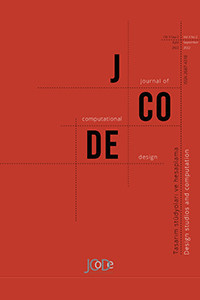Miselyumun Yetiştirilmiş ve Esnek bir Malzeme Olarak Kullanımı Üzerine bir Araştırma
Biyo-temelli malzeme tasarımında yapılan son çalışmalar, miselyumun -mantarların vejetatif kısmı- toprak altında büyümesi süresince oluşturduğu ince beyaz filamentler ağının sünek bir matris ve yüksek mukavemetli takviyeden oluşan kompozitler için bir alternatif olabileceğini göstermektedir. Miselyum, doğal bir kendi kendini bağlayıcı olarak hareket ettiğinden, miselyumun serbest form geometrisinde bağlayıcı bir madde olarak kullanılma potansiyelini tartışmayı amaçlamaktadır. Bu çalışmada, kumaş kalıp kullanılarak miselyum bazlı malzemelerin şekil alma ve yeniden şekillendirilme kabiliyetleri tartışılmıştır. Bu potansiyel, sınır koşulları ayarlanabilir bir kalıp üzerinde yeniden şekillendirmeyi araştıran bir dizi deney ile gözlenmiştir. Bu kapsamda, miselyum esaslı malzeme ve kumaş kalıp deneyine dayanan dijital ve analog araçların uygulanmasıyla dökümü yapılan malzemenin başlangıç ve bitiş şekilleri arasında bir karşılaştırma yapılmıştır. Hazırlanan deney düzeneği, tasarımcının kumaş kalıbının sınır koşullarını manipüle edebilmesini sağlar. Buna göre, farklı başlangıç geometri alternatifleri oluşturulmuş ve deformasyon, üst ve kesit görünüşlerde zamana dayalı olarak gözlemlenip ölçülmüştür. Dijital araçların yardımıyla deneyler bir oluşum süreci olarak belgelenmiştir. Belirli koşullar altında şekillenen malzemeyi ifade eden miselyum esaslı malzemenin kabiliyetini incelemek için iki farklı yaklaşım izlenmiştir. İlk yaklaşım, sabitlenen kumaş kalıbının dijital tasarım araçları ile tanımlanan başlangıç geometrisini korumak ve ortaya çıkan analog şekli elastik deformasyon yoluyla saptamaktır. İkinci yaklaşım, bir kumaş kalıbı içinde mümkün olan en yakın uyumluluk çözümünü bulmak üzere son analog geometriyi sabit tutmaktır.
Binding Behavior Study of Mycelium in Flexible Formwork
Latest studies in cultivated material design depict that the vegetative part of a fungus consisting of a network of rhizomatic and fibrous white filaments, the mycelium, could be an alternative for composites which composed of a ductile matrix and high-strength reinforcement. The goal of the present work is to discuss the potential of the usage of mycelium as a binding agent in free form geometry since mycelium acts as a natural self-assembling glue while following its metabolic cycle. Hence, shaping and re-shaping capabilities of mycelium-bond materials using fabric formwork is discussed. This study is the result of a series of experiments about mycelium-bond material that aims to investigate its re-shaping potentials by using an adjustable mold. We aim to make a comparison between initial and end shapes of cast material by implementing digital and analogue tools based on mycelium-based fabric formwork experiment. The formwork enables the designer to manipulate the boundary conditions of the fabric mold. The physical experiment setup consists of different initial geometry alternatives and the deformation is observed and measured numerically by time-based recording on top and section views. With the help of digital tools, experiments were documented as a process of formation. To analyze the mycelium-bond material, which refers to a material which can take form by growing mycelium under certain conditions, shaped by fabric formwork two different approaches were followed. The first approach is to keep the initial geometry defined by digital design tools of the fabric formwork fixed and to determine the resulting analogue shape from elastic deformation. The second approach is to keep the final analogue geometry fixed then to find the closest fit solution possible within a fabric formwork.
___
- Elbasdi, G., Alacam, S. (2017). A Study on the Materialisation and Formation of Mycelium in Fabric Formwork. In M. J. de Oliveira and F. C. Osorio (Eds.), Proceedings of the Kine[SIS]tem International Conference 2017 (pp. 275-283). Lisbon: DIN MIA’CET-IUL.
- Elbasdi, G., Alacam, S. (2016). An Investigation on Growth Behaviour of Mycelium in a Fabric Formwork. In A. Al-Attili, A. Karandinou, B. Daley (Eds.), Proceedings of Parametricism Vs. Materialism: Evolution of Digital Technologies for Development 8th ASCAAD Conference
(pp. 65-74). London: Imperial House Publishers.
- Hebel, D., Heisel, F. (2017). Cultivated Building Materials. Basel and Berlin: Birkhäuser. Veenendaal, D., Block, P. (2012). Computational Form-finding of Fabric Formworks: An Overview and Discussion. Ohr, J. et al. (Editors). Proceedings of the 2nd International Conference on Flexible Formwork. Bath, UK, 368-378.
- Url-1 < www.fabricforming.org>, date retrieved 10.06.2016.
